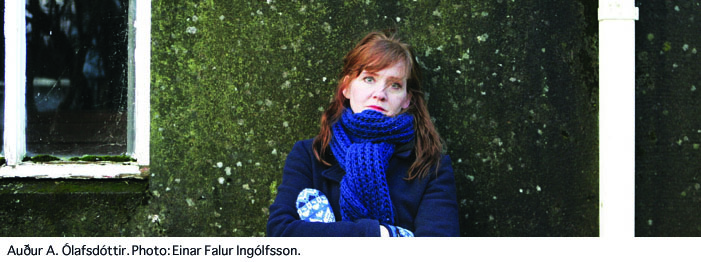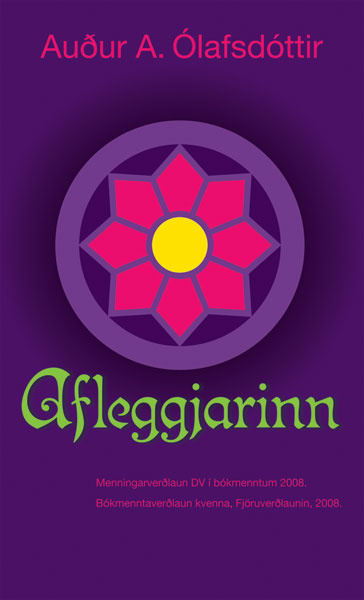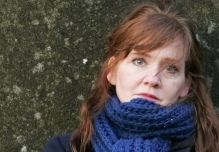Auður A. Ólafsdóttir
“Beautiful, like a painting out of the golden age,” was a critic's verdict on Auður A. Ólafsdóttir's novel Afleggjarinn (The Greenhouse), the story of a young man who sets out to restore a dilapidated monastic garden to its former beauty.
“Beautiful, like a painting out of the golden age,” was a critic's verdict on Auður A. Ólafsdóttir's novel Afleggjarinn (The Offspring), the story of a young man who sets out to restore a dilapidated monastic garden to its former beauty.

Auður A. Ólafsdóttir published her first work of fiction, Upphækkuð jörð / Raised Earth, in 1998. Since then, two more novels have followed in its wake, as well as the poetry book Sálmurinn um glimmer / The Psalm of Glimmer, published in early 2010. Ólafsdóttir's work has attracted praise for its fresh perspective on everyday life. A review of Raised Earth in the newspaper Morgunblaðið stated that the work's aesthetic approach consisted of “dissecting, ever more finely – almost down to the microscopic level,” and this is arguably an underlying theme in all her subsequent fiction. Her books don't describe momentous events, but focus on the small things in life, ruled by the aesthetic of day-to-day life.
Her two subsequent works, Rigning í nóvember / November Rain and The Greenhouse, enjoyed universal critical acclaim. The critic of Morgunblaðið demanded: “More! More!” after reading November Rain, which won the Tómas Guðmundsson Literary Award, while The Greenhouse received the DV Culture Award, The Prize for Icelandic Women's Literature, and a nomination for the Nordic Council's Literary Award. The panel of judges for the DV Award stated that the novel succeeded in casting off the fetters of convention: “This work strikes a new note on the Icelandic scene.” The critic of Morgunblaðið declared the book to be, without a doubt, “one of the strongest novels of 2007.”
Traveling through an unnamed country
The Greenhouse tells the story of a young man who travels through an unnamed country with three rose cuttings. His goal: to restore a dilapidated but once-renowned monastic garden to its former beauty.
The young man – whose interests include rose cultivation, sex and death – leaves behind a young daughter, accidentally conceived with a woman who is little more than “a friend of a friend.” Following a surprise visit from home, he is left to care for the unusually precocious child, who is already picking up her first Latin words. Through its subtle religious symbolism and mysticism, The Greenhouse examines the human experience in a modern, vivid, and low-key way.
Part of the cultural baggage
For the past few years, Auður Ólafsdóttir has worked as an art historian for the University of Iceland. Has her academic background influenced her approach in any way?
“I think the main consequence is that I'm working full-time, and that means there's a longer gap between books," she says. "The paintings are a rather complicated business. They are part of my cultural baggage – thousands of pictures in all shapes and sizes. There's often a picture beneath my layers of text, but not necessarily out of art history. A Danish critic once wrote that The Greenhouse was “beautiful, like a painting out of the golden age.” I immediately wondered if he meant a painting from the 16th or 17th century. And which particular painting? It kept me thinking for a while.”
Elevating the commonplace
An innate curiosity for language led Ólafsdóttir down the road of fiction.
“At an early age, I became conscious of speaking a language understood only by a few,” she says. "As a writer today, I feel this is a great privilege. Because of its inaccessibility to the world, Icelandic literature has a head start in terms of mystique. My view of the world has always been slightly skewed. Then, out of nowhere, there is this urge to create fictitious worlds with their own laws. Maybe it stems from a strong need for freedom.
“I wanted to approach the illogical part of the human psyche in a musical way, to elevate everyday experiences – even to to give them a religious dimension like in The Greenhouse. Like many writers, I want the world to be different from the way it is. Once, before I started writing novels, I was wandering around the Pyrenees, and happened upon a convention of love story writers. Never before had I seen a group of people so un-writerly in appearance – not that writers are supposed to have some kind of uniform appearance. They seemed to have a definite color scheme going – lots of purple. And I got to thinking that it might be nice to be invited to a conference like this one day. Since then, love has been a constant theme in my work.”
Writers are foreigners to their mother tongue
One major characteristic of Ólafsdóttir's fiction is a strong consciousness of the limits and possibilities of language – the idea that each language harbors a unique mode of thought. Now that The Offspring has been translated into Danish and French, and is due to appear in German in 2011, how does she feel about it?
“While much is lost, of course, each each language also offers new possibilities. I've been very fortunate with translators – they have succeeded beautifully in reproducing the rhythms, which is probably the hardest part of a translator's job. The French edition of The Greenhouse will be out in August 2010. The French chose a new title for the work: Rosa candida, which is the name of the rose cultivated by the novel's protagonist, but also an ancient term for the Virgin Mary. When discussing the work, the French make the term candide correspond to the innocence and purity of the young father in the book, and also connect it to Voltaire's Candide. Danish readers, on the other hand, found the protagonist's trust towards strangers and foreigners remarkable, and made a connection to Dostoyevsky's The Idiot. We mustn't forget, either, that writers are foreigners to their mother tongue. Their job is to misunderstand language.”
